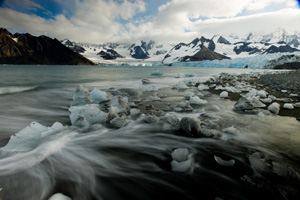

Back in film days, what, five or six long years ago now, photographers
might have a collection of filters in their gadget bags. These
might include 81A filters for warming a scene, a graduated neutral
density filter, various colored graduated filters - Cokin made
many, a polarizing filter, and, perhaps, a neutral density filter.
Today, with digital and the ability to change the White Balance,
many color filters are unnecessary, graduated ND filters have
limited, or dubious value in some cases, and even one of the prime
uses for polarizing filters - to enhance blue skies - has been
rendered less important via selective RAW color adjustments. So,
does one even need a filter today?
Today, I only carry two. I still use a polarizing filter to enhance
skies and to pop out clouds (although, as stated above, if I forget
the filter I can do almost as good a job with the RAW converter),
but more importantly, a polarizing filter reduces glare and reflections,
and I know of no digital trick that can replicate that effect.
Polarizers, then, can enhance the colors in a fall foliage scene
by removing the waxy glare off leaves or grasses, tree bark, or
shiny rocks, and thus enrich the color and saturation and general
richness of a scene.
A lot of photographers automatically reach for a polarizer
when they are shooting stream or water scenes, as a polarizer
will reduce or totally eliminate glare or reflections of the sky.
This works, but one should use a little prudence when doing so,
because the presence of some reflection may actually help, and
actually create the sense that water is, indeed, present. In a
forest stream scene, for example, if the reflection of a sky is
eliminated you might end up with what looks like a waterless stream
bed strewn with rocks. Reflections in such cases actually adds
to the scene, providing a sense of water that clear, reflection-less
water cannot.
When I am shooting water, I do think about using an entirely different
filter, the Singh-Ray Variable Neutral Density Filter. This filter
operates similarly to a polarizing filter, since the variable
filter rotates and, by doing so, increases or decreases the amount
of neutral density filtration without affecting the color of the
scene. With it, I can use slow shutter speeds even in bright light,
which can be very useful for doing 'angel hair' or 'cotton candy'
like water - ie water that is shot at very slow shutter speeds
so that the current seems to blend.

How difficult
is it to master MASKS?
WHY WE SWITCHED FROM Nikon to Canon
Does the automatic sensor cleaning feature of the Mark III really
work?
What is our initial Digital Workflow?
What is our Digital Workflow
in the Lab?
How
do I keep track of Digital Files?
Is Shooting in the RAW
format worthwhile?
What
is the Difference?
How can you capture
a sharp image and angel hair on a windy day?
Can you match
the Histograms?
How
do we meter White?
Is the Mark
II the ultimate wildlife digital camera?
What
is DEC?
Wildlife
Models - Is there anything new to shoot?
Do
You Need a Big Printer?
Can
a Wimberley Head be used with small lenses?
What
is Reality? Adobe's powerful LIGHTROOM Program
Why
must you have at least 2 digital backups?
Is Digital Manipulation
- a benign alternative to interacting in the natural world?
Film
or Digital? - Why
you should shoot film!
Does the Visibledust
cleaning system really work?
How
do you shoot from a small boat?
Photo Trap - The Pro's Secret Weapon
LensCoat camera, lens, and tripod covers
What Equipment
do we usually take afield?
Does
the AutoFocus on the EOS 1D Mark III work?
Which Macro Lens is for You?
What is the Most Important thing you can do before a Workshop?
How
many Flashes do you need to effectively illuminate hummingbirds?
What
is the best shutter speed for panning running mammals?
Is
there an easy way to level a camera for panorama shots?
Is
the New Wimberley head worth having?
Is an L-Shaped Camera
Bracket worth the Money? You bet it is!
Using Zoom
lenses with tele-converters and extension tubes -- can you use
both together?
Are Image Stabilization
Lenses Worth the Money?
What
the heck is the Scheimpflug Law?
What
is the Best Composition?
Should
you have a depth of field Preview button on your camera?
How
do you determine distances?
Hyperfocal Distance
Apertures
for Macro
Flash and
Tele-flash Techniques
What
is the best flash for closeup and macro photography?
What is the
most versatile remote release camera firing system?
How
do you shoot high-speed action images?
How
did I shoot the gliding Sugar Glider?
How did I
photograph that flying wasp?
What the
heck is a Plamp?
Can
Photographing Wildlife Models make Conservation Sense?
Is Kenya safe to visit in 2008?
What I did on my summer 'vacation.'
Why is Yellowstone the best for wildlife photography in the US?
Is
a Trip to Antarctica Worth it?
What is the best season
to do a photo safari in East Africa?
What is the Big Lie?
The truth about Kenya's Tourism--it is SAFE!
Which Mountain
Park is better for wildlife - Denali or Torres del Paine?
What
are our Five Favorite Shooting Locales?
How can you
attract insectivorous birds to your feeding stations and bait
sites?
How do you
make things happen in wildlife photography?
What is the
best Car Window Mount?
How
can you save your shoulders?
How can you reduce
contrast and the effect of wind for flower and macro photography?
What
is the best Game Caller?
How Easy
is Whale Photography?
Why
Can't You Feed A Bear?
What is our
Favorite bird-shooting location?
Contact us by e-mail: info@hoothollow.com